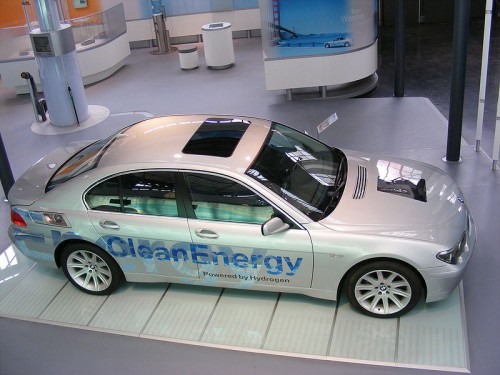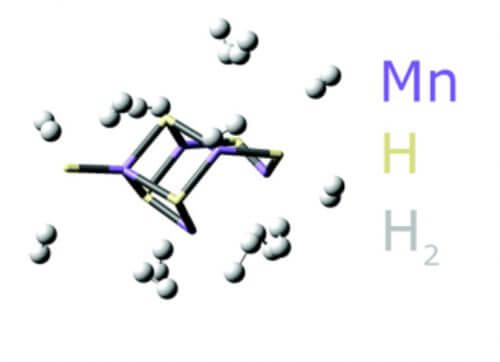Scientists have succeeded in developing a new material that could significantly contribute to the advancement of the field of hydrogen vehicles
[Translation by Dr. Nachmani Moshe]

As the world moves away from fossil fuel-powered cars and trucks, greener alternative technologies are being tested, such as battery-electric vehicles. Another "green" technology with great potential is hydrogen fuel. However, a significant setback was the size, complexity and cost of these fuel systems - until today.
An international team of researchers, led by Professor David Antonelli from Lancaster University, has discovered a new material consisting of manganese hydride that brings us closer to an efficient and cheap hydrogen fuel. The new material will be used to make molecular spacers inside the fuel tanks - those systems that store the hydrogen and work alongside fuel cells in a hydrogen-based propulsion system. The material, called KMH-1 (Kubas Manganese Hydride-1), will enable the design of tanks that will be smaller, cheaper, more convenient and more energy-intensive than existing technologies in the field of hydrogen fuel, a result that will result in much better performance than electrically driven vehicles. Explains the lead researcher: "The cost of producing our material is so low, and the energy density it can store is much higher than that of a lithium ion battery, so we expect to see hydrogen fuel cell systems that will be five times cheaper than batteries and that will be able to drive the vehicle for a long time Four or five times larger than what exists today in electric vehicles."

The material utilizes the chemical process known as Kubas binding, a process that allows hydrogen to be stored by embedding hydrogen atoms inside a hydrogen molecule (H2) at room temperature. This process eliminates the need to break and reconnect chemical bonds between atoms, steps that exist at the base of common processes, and which require extremely high energies and temperatures, using complex and expensive equipment. The new material also absorbs and stores the excess energy, so there is no need for external heating or cooling. This fact is critical since its meaning is that there is no need to use cooling or heating equipment inside the vehicles, which will give rise to systems with a high potential for higher performance and efficiency than those that exist today.
The expansions work by adsorbing hydrogen under conditions of 120 atmospheres, a pressure lower than that of a diving tank. Next, when pressure is released, the expansions release hydrogen from the tank into the fuel cell. The experiments of the researchers show how the material is able to store an amount of hydrogen four times greater than the amounts stored within current hydrogen technologies. This finding is excellent for vehicle manufacturers since it provides them with the flexibility to design vehicles with up to four times longer driving range, or a fourfold reduction in the size of the tanks.
Although vehicles, including cars and cargo trucks, are the obvious application, the researchers believe that many other applications will develop for the innovative material. "This material can also be used in portable devices such as drones or in mobile phone chargers so that people can go on camping trips for an entire week without having to charge their mobile devices," explains the lead researcher. "The real advantage that this application generates lies in situations where you expect to be out of range for long periods of time. It could also be used for remote operation of a residence or even a neighborhood without using fuel."
The article describing the study
More of the topic in Hayadan:

16 תגובות
gibberish gibberish an exaggerated dream of the developers.
How do you "fuel" such a car?
Can it succeed compared to an electric vehicle that the reason why it doesn't catch on is that there is nowhere to charge it?
Yehuda Elide: What is this nonsense about hydrogen that "burns" but "doesn't explode"? I myself conducted an experiment in which I trapped hydrogen inside a metal tin. I punched a small hole in a tin - and turned on the jet of hydrogen gas that flowed from the hole; It was an almost transparent flame, bluish in color. Of course, when the hydrogen came out of the can - air went in to equalize the pressures. After about two minutes, when inside the can there was an optimal molar ratio between hydrogen and oxygen - a strong explosion occurred that literally tore the can open. So here is a real experiment that I ran myself - which showed that hydrogen can definitely explode!
Regarding your second nonsense - "air-hydrogen bombs": the reason there are no such bombs is that hydrogen is a much lighter gas than air (this is true on Earth up to about 100 km above sea level) - therefore if you release hydrogen from an airplane and want to ignite it - The hydrogen has long since not been found in the place you dispersed, unlike a fuel-air bomb, in which the fuel vapors remain for tens of seconds (more or less) in the area where they were released.
In a vehicle / any system powered by hydrogen, the priority is apparently to produce the hydrogen while moving in sufficient quantity and with low consumption...mainly in the safety aspect...the answer to this, in my humble opinion, lies in balance...that is, in a multi-system integration that includes both electricity and solid propulsion as well as a system for breaking down hydrogen and balance Calculated...experience has shown that when you do not create a balance in the conversion of one type of energy to another, chaos or an uncontrolled conversion is created that in one way or another will damage the environmental system...see the example of the following "green" solutions: desalination, wind turbines, surplus electricity in the conversion of a triangular star, cables Drainage, etc.
Let's take for example desalination, a solution to water shortages on the one hand, and on the other hand, damage to the population of life in the water due to the concentration of salts.
Or for example a wind turbine that produces a green solution for electricity production on the one hand but harms the biodiversity of the winged animals....
Or alternatively, a triple star conversion that is not properly maintained by end consumers...creates very significant wear and tear on the hate systems...
and so'……
And all these examples are of imbalance in energy conversions..
For all those concerned about the explosiveness of hydrogen: as you can see in the pictures from the Hindenburg incinerator (the reason why the Zeppelin technology was not developed further), hydrogen burns but usually does not explode in air. At least, it represents a lower danger than gasoline vapors, which also explains why the militaries developed "fuel-air bombs" for massive volume explosions and not hydrogen-air bombs.
On the other hand, if the optimism of the authors of the article has anything to be based on, the Israeli Navy will find the innovation very interesting. It is possible to increase 4-5 times the length of stay under water of the submarines bought in Germany, which have energy supply from fuel cells for a long stay without lifting a "snorkel" (AIP submarines in the military jargon), thus realizing the wet dream of a "nuclear submarine for the poor" ” which can be used as an essential element in the strategy of nuclear deterrence against Iran (the launch tubes for the missiles have already been included in the planning as part of the changes that Israel is demanding).
When is there any chance we will see cars powered by this new petroleum fuel
And how exactly will they compress hydrogen at a pressure of 120 atmospheres in the car / the other devices?
Kudos to the developers
I wish we had
I think Toyota already has such a vehicle,
Mirai which is marketed in the USA and Europe
Yossi: Kabras are filters (unit: kabra).
Amos: In a car accident between a hydrogen-powered vehicle and another vehicle - at the right speed, angle and direction - the hydrogen tank can be damaged (even if the impact is not strong), and then the enormous pressure of 120 atmospheres will cause a tremendous explosion, much more significant than the explosion of a "normal" car containing 45 liters of fuel. So, for example, if the volume of the hydrogen tank is "only" about 20-30 liters, a car accident inside a tunnel could result in many losses in body and soul, and in addition damage to the structure of the tunnel itself - which could simply collapse.
as a sieve
The danger is not from a spontaneous explosion, but as a result of a malfunction or worse - sabotage
sieve = kabra or strainer
I don't know why the writer preferred to use the word Kabra (the correct one) over Sienna (the correct and more familiar one)
Distances? What is? Do you mean beehives?
Gasoline is also flammable. As described, the material is held under high pressure, i.e. in a sealed container. Until now I have never heard of a gas powered car that exploded.
What about the high flammability of hydrogen? This was the reason why there are no such vehicles today. Now it's four times more flammable? Yani is a respectable bomb.